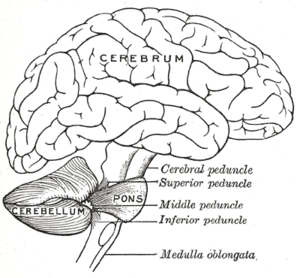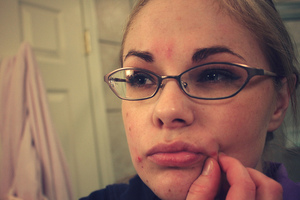What part of the brain controls movement? Well let’s say that there is more to movement and balance than just walking, running and using your hands to do the daily activities that need to be done. Without your brain none of these functions would be possible, especially the part of the brain that controls our balance and movements.
That part is called the cerebellum. It can be found at the back of the brain, below the cerebral cortex and above the brain stem. Even though it is only 1/8 the size of the cerebrum, this structure is very important to the coordination of our movement , our balance and the timing and precision in which these functions are done. In other words, it contributes to the fluidity and coordination of all our movements.
Think of picking up a pencil and the force, speed and contractions that are necessary to perform the task of writing. Think of jogging and the coordinated action of lifting and lowering your legs to actually run, and think of keeping your balance while riding a bicycle or just sitting on the edge of your chair. Think of the muscles that are involved in each of these functions and know that it’s the cerebellum that makes all this possible.
Discovery Of The Relationship Between Movement and the Cerebellum
There has always been a lot of speculation about the function of the brain and the cerebellum in particular. But it was Luigi Rolando, a professor of anatomy, who discovered the connection between motion or movement and the cerebellum. In 1809 the professor experimented on the cerebellum of animals and concluded that if this structure was damaged, it would disrupt the animal’s motor control and cause paralysis.
Unfortunately, his writings about these experiments were limited and was relatively unknown to a lot of the scientific community.
During this time however, French physiologist and founder of experimental brain science, Marie Jean Pierre Flourens, was doing the same experiments as Rolando and came to some of the same conclusions. The difference Flourens discovered is that damage or removal of the cerebellum will cause uncoordinated and spastic movements, but it did not cause paralysis as stated by Rolando.
What happens When the Cerebellum is Damaged
Because the cerebellum controls your motions, balance and stores your motor memories, when this structure is either damaged, scarred or has lesions, the person’s fine motor coordination becomes uncoordinated or spastic. They are able to walk, but it will be more of a stagger and sway motion.
Needless to say, the person will not only have loss of their coordinated motor movement, they will also experience an inability to judge distance, when to stop and the inability to do fast alternating movements. There will also be slurred speech, abnormal eye movement, muscle weakness, movement tremors and episodes of falling. Damage to the cerebellum will not paralyze a person, but as you can see, their fine motor skills will become disrupted.
Some Disorders That Affect the Cerebellum
Midline Cerebellar Syndrome
A person suffering from this ailment may have nausea and vomiting. They will have trouble with their balance, they won’t be able to stand with their eyes open or closed. They will have to steady themselves when sitting on the edge of a chair or bed, and they may also experience bobbing of the head.
Hemispheric Cerebellar Syndrome
A person with this ailment will have no coordination of their limbs. They will exhibit tremors when trying to touch an object and may not be able to perform the simple task of touching their finger to their nose. Their rapid alternating movements will become irregular and there could also be dysarthric, which is poor articulation of words.
Alcoholism
The fluidity of your movements or walking comes from nerve signals coming from the medulla and being received by the cerebellum. Alcohol can interrupt these signals and cause a person’s balance to be off and their movements to become jerky, staggering and uncoordinated.. This is why you see someone who happens to be drunk, taking one step forward and perhaps two steps back. Excessive alcohol intake also kills brain cells that cannot be replaced or regenerated.
Cerebellar-Stroke
This condition is also referred to as hemorrhagic bleeding or cerebellar hemorrhage and can be caused by unchecked high blood pressure that is allowed to continue. You will experience vertigo, dizziness, problems with your balance, rapid eye movement, difficulty swallowing and speaking.
Arnold-Chiari Malformation
This is a condition where the cerebellar tonsils are turned downward in relation to the skull and will sometimes cause hydrocephalus – a build up of fluid in the skull. As a result of the obstruction of cerebrospinal fluid outflow, the person can experience muscle weakness in the face and head, have difficulty swallowing, experience dizziness, nausea, impaired coordination, headaches, fatigue,and in extreme cases they may also experience paralysis.
We tend to take so much for granted when it comes to our lives and the hundreds of motions we go through every day, but without our brain and all the simple and complex functions it performs for us, we would be totally lost. Walking, running, surfing, winking and even the simple task of twiddling our thumbs are all things we do automatically without thinking, and the cerebellum is the structure that makes all this possible.


